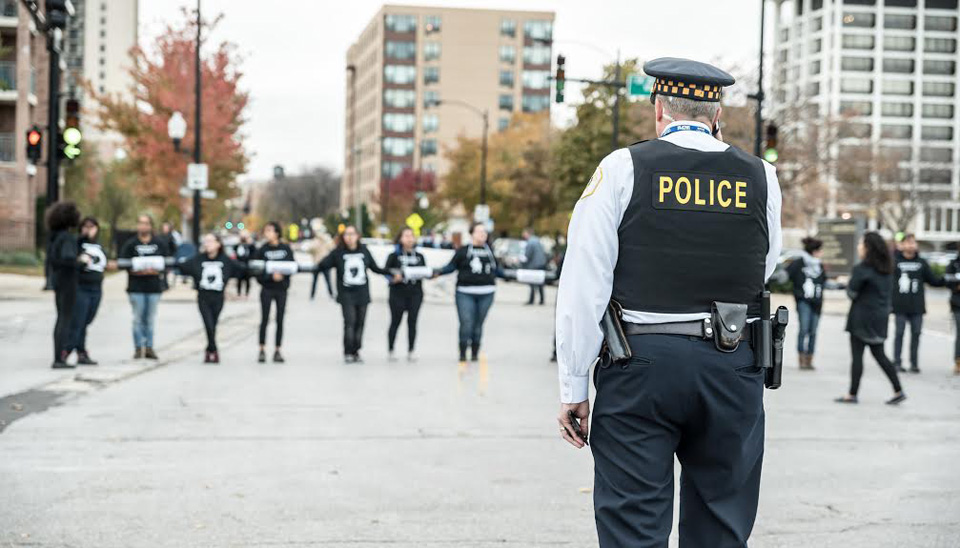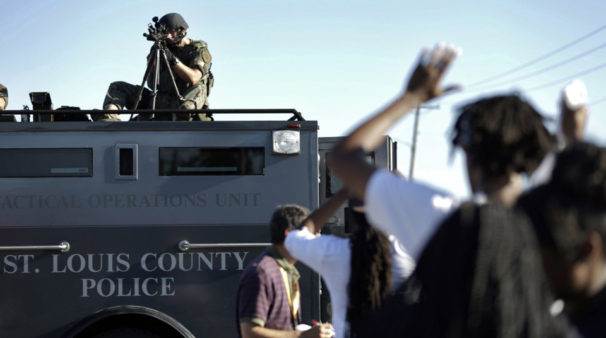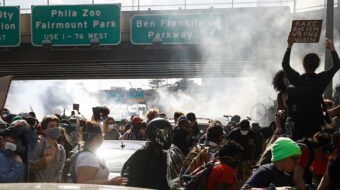
The last several months have been filled with constant images of police brutality, from the death of 13-year old Tyree King, to the more recent shooting of Terence Crutcher, a 40-year-old black man who was shot in the middle of the road while he had his hands up. The continuing streak of violence against marginalized citizens has not ceased, and, furthermore, legal repercussions for the officers involved in similar incidents have remained virtually non-existent.
Lately, it has become standard procedure in some instances of high-profile police misconduct that the Department of Justice opens an investigation for civil rights violations. It seems, however, that the legal system uncritically shields any action taken by those charged with enforcing the law; a majority of police are never indicted. While events are handled on a case-by-case basis, investigated officers are often put on administrative leave, thus securing their benefits and salary while the investigation proceeds. While, some may argue that even cops are “innocent until proven guilty, it seems that same benefit of the doubt is often not often awarded to their victims.
Politicians have proposed various reforms over the years; there are attempts to deal with implicit bias, such as diversity or sensitivity training, as well as increasing access to “non-lethal” forms of control – such as tasers. The overall effectiveness of these approaches is still in question. While these trainings may serve to promote more caution, they don’t address the root of the issue, which is that police and prison systems are built as a means of social control. They thrive off the oppression of black and brown communities, disproportionately target black/Latinx individuals.
Nationwide, some organizers and activists have turned to what they consider to be the best solution: abolition.
Is abolition possible?
The abolition of para-militaristic forces and the existing mechanisms of incarceration (prisons, police, ICE, etc.) is undeniably controversial. Take a look at any report, study, or analysis on the matter and you’ll find varying proposals for how to tackle police brutality. One of the main points abolitionists emphasize, however, is that, statistically, police actually do very little “protecting.”
According to David Graeber, an activist and anthropology professor at the London School of Economics, police sociology studies have found that only about 10 percent of the average police officer’s time is devoted to criminal matters of any kind. He notes that most of the remaining 90 percent is spent dealing with infractions of various administrative codes and regulations. “If two people punch each other, or even draw a knife on each other, police are unlikely to get involved,” he says. “Drive down the street in a car without license plates, on the other hand, and the authorities will show up instantly.”
What is more, departments stand to benefit financially from criminalizing poverty, such as pursuing minor infractions that can be ticketed, and perpetuating the incarceration of black and brown individuals. Meanwhile, organizations like the American Legislative Exchange Council (ALEC), focus on ways to pass laws that grant corporations loophole access to cheap prison labor.
So what does this all mean about the effectiveness of police forces? For one, police seem to view their jobs as existing primarily to protect property, not people. Second, police are not being used effectively. The data on violent crimes reported through the FBI and Bureau of Justice Statistics indicates there are an average of 1.36 violent crimes reported annually per police officer employed in the U.S. To actually solve such crimes would require a restructuring of police forces so as to reduce the inefficiencies that exist. In the meantime, police forces try to convince the masses of their supposedly necessary role in society by hiding behind a veil of “law and order.”

Who is endorsing abolition?
Community policing ordinances are being pushed by activists all over the country through groups like the Civilian Police Accountability Council, which was put together by community organizers from the Chicago Alliance Against Racist and Political Repression. Similarly, other community groups have begun to organize around abolition. Just this past summer, the Chicago-based Let Us Breathe collective, in collaboration with the national BYP100’s blockade action, launched a “Freedom Square’ occupation in front of the CPD black site, Homan Square. They remained there for several months, not only challenging the destructive systems of policing, but also modeling a world without police or prisons. Eventually the space was handed over to Lawndale community members, as the Let Us Breathe collective continues to strategize around other liberation-based projects.
Other leaders, such as national Black Lives Matter co-founder Alicia Garza, have voiced support of “police-free” communities. Garza stated that policing as a whole is problematic: “In the ethos of this country, police can do no wrong. And if and when police do wrong, it’s a case of individual bad apples, as opposed to a corroded and corrupt system.” Garza’s comment touches a nerve for many Americans who lack a thorough knowledge of the ways in which incarceration in this country is rooted in oppressive and archaic mechanisms of anti-blackness and oppression.
Racist origins of modern policing
Last week, Ava DuVernay, African-American female director of Selma, released 13th – a documentary on Netflix which highlights the direct ways in which the development of American policing is correlated to institutional slavery in the United States. The film points to language written in the constitution which became a loophole to legalized slavery. Clearly stated in Section 1 of the 13th Amendment: “Neither slavery nor involuntary servitude, except as a punishment for crime whereof the party shall have been duly convicted, shall exist within the United States.”
This comes as no surprise to historians, who have spent years researching the statistical correlations between the spike in prisoners after the Emancipation Proclamation. Victor E. Kappeler, a professor in the School of Justice Studies at Eastern Kentucky University, has elaborated on the ways in which slave patrols provided the template for policing in its contemporary sense. “Slave patrols and Night Watches, which later became modern police departments,” he has shown, “were both designed to control the behaviors of minorities.”
Kappeler also highlights the ways in which appointed “constables” targeted other black and brown communities, such as Native Americans. The St. Louis Police were founded to “protect” residents from indigenous populations in the frontier city – a practice that has continued on in modern constructs, with police violence affecting Native Americans at a higher rate than any other racial group.
Ultimately, slave patrols were meant to assist wealthy landowners in “recovering” property, thus continuing the commodification of black and brown bodies – not unlike the system in place today. Prisons primarily benefit wealthy investors and focus minimally on the rehabilitation aspect of incarcerated members. Police officers serve as pawns in these structures and perpetuate the systems of discriminatory imprisonment that many have equated to a modern-day Jim Crow system, and even slavery.
What does a world without police look like?
There are many who remain doubtful about the pragmatism of abolition. There are a number of alternatives, however, that are emerging in activist communities, such as restorative and transformative justice practices which emphasize repairing the harm caused by criminal behavior. These methods, although newer, have been endorsed by experts in racial hegemony and incarceration, such as Michelle Alexander, author of The New Jim Crow: Mass Incarceration in the Age of Colorblindness. Restorative justice is not a practice written in stone, but can be accomplished through “cooperative processes” that include all stakeholders and center the voices and needs of victims.
Several organizations, such as Black & Pink, which focus their activism around Queer incarcerated persons, have publicly endorsed abolition, stating that there “there is no liberation for LGBTQ people within the institution of policing.” In a statement to People’s World about their abolition organizing work, a spokesperson for Black & Pink said, “we focus on education and advocacy. A huge part of our work as organizers is to start a dialogue about abolition and introduce the idea to many people who may not be familiar.”
Black & Pink recently gathered the largest set of data to date on LGBTQ incarcerated people, titled Coming Out of Concrete Closets, in order to bring to light the experiences of Queer incarcerated individuals. This is just one step of many that they have taken towards uplifting the voices of those who have been directly impacted by the oppressive mechanism of state-sanctioned violence. It also sheds light on the dehumanizing practices in prisons at the hands of guards and police.
Abolition advocates understand that it is not going to be an overnight process. Alex Garza, a Chicago activist who recently partook in an action against the Illinois Tactical Officers Association Conference, said to People’s World that on a personal level, abolition would mean “replacing punitive culture with restorative practices.” This would entail implementing programs for community policing and accountability systems, as well as providing essential resources for decent living (shelter and healthy food), harm reduction practices that address trauma and help transform a situation before it reaches the need for state “intervention.” Garza says the key is “addressing trauma with love, healing and support, instead of punishment.”
Ultimately, police are just one branch in an intricate system of oppression within this country. We cannot change an entire institution with legislative policy alone, especially when it was designed with the purpose of criminalizing black and brown people. The efforts that currently pass for “reform” distract from the foundational issues that create conditions of incarceration and crime.
People need resources, they need employment, they need the means to survive. We cannot provide the solution through ‘free hugs’ or community barbeques. We must defund, disarm, and disband the police.












Comments